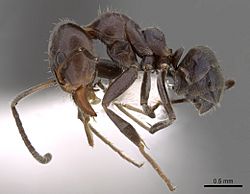Iridomyrmex rufoniger facts for kids
Quick facts for kids Iridomyrmex rufoniger |
|
|---|---|
 |
|
| I. rufoniger worker specimen | |
| Scientific classification | |
| Kingdom: | |
| Phylum: | |
| Class: | |
| Order: | |
| Family: | |
| Subfamily: |
Dolichoderinae
|
| Genus: | |
| Species: |
I. rufoniger
|
| Binomial name | |
| Iridomyrmex rufoniger (Lowne, 1865)
|
|
| Synonyms | |
|
|
Iridomyrmex rufoniger is a very common type of ant found in Australia. It is sometimes called the "black house ant" or "meat ant" by people. These ants belong to a group of ants known as Iridomyrmex. A scientist named Lowne first described this species in 1865. You can find them in almost every part of Australia. They have also been accidentally introduced to a few other countries.
Contents
About This Ant's Name
Scientists give every living thing a special name, like Iridomyrmex rufoniger. This helps everyone know exactly which creature they are talking about. This ant was first given its scientific name by Lowne in 1865.
Older Names for This Ant
Sometimes, an animal can have more than one scientific name over time. These older names are called synonyms. For Iridomyrmex rufoniger, some of its older names include Iridomyrmex rufoniger domesticus and Acantholepis mamillatus. This ant is part of the Iridomyrmex genus. This genus belongs to the Dolichoderinae subfamily of ants.
What This Ant Looks Like
Iridomyrmex rufoniger ants are part of a special group called the Iridomyrmex purpureus group. They are one of the most well-known ants in Australia. A typical worker ant is medium-sized compared to other ants in its group.
Key Features of the I. rufoniger Ant
These ants have a wide head. Their bodies, especially the back part called the gaster, often show a blue or yellowish-green iridescence. This means they can look shiny and colorful in the light. Ants found in Sydney can look a bit different. They often have a darker color and smaller heads than other I. rufoniger ants found elsewhere in Australia.
Where These Ants Live
I. rufoniger ants are found in every state and territory in Australia. However, they are not very common in the Northern Territory. They have also spread to the Solomon Islands and New Caledonia. They were even found in New Zealand at ports, but they haven't settled there permanently yet.
Ant Nests and Homes
These ants build many nests. They usually make their homes in the soil or under stones. Depending on where they live, they can be a very common type of ant in that area. For example, in Westonia, many colonies have made their homes in old mine dumps. However, they are not often found in the nearby natural bushland that has been replanted. These ants can live at many different heights above sea level. They have been found from 5 meters (16 feet) up to 1580 meters (5,183 feet) high. On average, they are found at about 244 meters (800 feet) high.
How These Ants Behave

I. rufoniger ants are active both during the day (diurnal) and at night (nocturnal). They often walk on eucalyptus trees to find nectar and honeydew. Honeydew is a sweet liquid made by some insects. These ants also hunt for other insects to bring back to their colony for food.
What They Eat and Who They Help
These ants are known to "farm" or tend to many different kinds of insects. This includes insects like Saisettia oleae and the aphid Aphis hederae. They also look after the young (larvae) of several butterfly species. Some of these butterflies include Jalmenus daemeli, Jalmenus evagoras, Jalmenus icilius, and Ogyrus zosine. The ants protect these insects, and in return, they get honeydew or other secretions. You might often see these ants foraging on flowers from the Leptospermum genus. Even though they are often found in homes in Canberra, these ants are not usually considered a pest.
See also
 In Spanish: Iridomyrmex rufoniger para niños
In Spanish: Iridomyrmex rufoniger para niños

